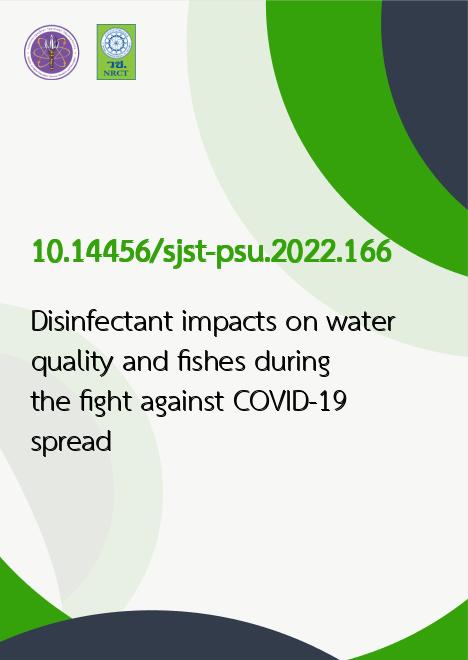
|
Disinfectant impacts on water quality and fishes during the fight against COVID-19 spread |
|---|---|
| รหัสดีโอไอ | |
| Creator | 1. Adams Ovie Iyiola 2. Ayotunde Samuel Kolawole 3. Berchie Asiedu 4. Seth Mensah Abobi |
| Title | Disinfectant impacts on water quality and fishes during the fight against COVID-19 spread |
| Publisher | Research and Development Office, Prince of Songkla University |
| Publication Year | 2565 |
| Journal Title | Songklanakarin Journal of Science an Technology (SJST) |
| Journal Vol. | 44 |
| Journal No. | 5 |
| Page no. | 1279-1286 |
| Keyword | COVID-19 spread, disinfection, fish species, human response, waste water disposal |
| URL Website | https://sjst.psu.ac.th/ |
| ISSN | 0125-3395 |
| Abstract | The World Health Organization recommended disinfectant use as a way of tackling the global spread of corona viruspandemic (COVID-19). A total of 246,245,186 infection cases, 246,134,984 recoveries and 4,995,890 deaths have been reportedacross the world with 3,767,744 confirmed cases in over 160 countries. The spread of the virus was addressed by restrictinghuman and vehicular movements, compelled use of sanitizers, social distancing, and wearing of masks. Chlorine, alcohol andbleach disinfectants, which contain different active compounds, were also used to combat the spread of the virus by applyingthem on surfaces. The indiscriminate use of disinfectants was reported to have disastrous effects on water quality, and on skinand organs of fish in the long run. The virus affected generally almost all spheres of life. To this end, disinfectants must be usedat recommended rate of application, and the proper disposal of wastewater is also important, so as to limit transmission ofdiseases. Strict adherence to human activities based on the approved guidelines by the government and stakeholders in the healthsector is essential for a healthy life. This paper therefore reviews the types of disinfectants, and their effects on water quality, fishspecies and sustainability of the environment. |
